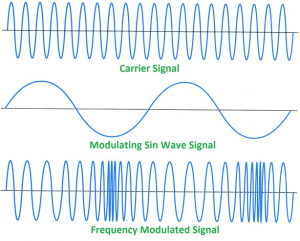Applications of Frequency Modulation
For generating a frequency modulated signal, change in the frequency of radio carrier is brought to be in line with the amplitude of the given incoming audio signal, with modulation in audio signal, there is up and down movement in frequency of the newer frequency signal. Deviation is the amount by which the signal moves up and down. Frequency Modulation is the demodulating the signal back to its original state.

Frequency Modulation is the encoding of the information in a carrier wave by varying the instantaneous frequency of the wave. Frequency Modulation is in contrast with amplitude modulation where amplitude of the carrier waves is modulated with frequency remaining unchanged and constant.
In the Analog Frequency Modulation, the difference between the frequency of the carrier and the centre frequency is directly proportional to the modulating signal. Digital date can be transmitter and encoded via. FM through a shift of carrier’s frequency along a predefined set of frequencies which represent digits.
Applications of Frequency Modulation:
⇒ Telemetry, radar and seismic prospecting, EEG monitoring of new-born’s etc. also use the technique of frequency modulation.
⇒ Frequency modulation can be used for the broadcasting of FM radio. This helps in larger signal to noise ratio.
⇒ It is also used in music synthesis, some systems that use video-transmission and also for magnetic tape-recording systems.
Advantages of Frequency Modulation:
⇒ Frequency modulation is also resilient to noise and interference.
⇒ Frequency modulation is resilient to signal level variations. Any variation in signal level does not affect the output as long as the receiver is able to cope up with the signal level. This makes the FM ideal for two-way radio communication or mobile communication application.
⇒ It is also easier to apply modulation at a low-level power stage of a transmitter.
Disadvantages of Frequency Modulation:
⇒ FM doesn’t have as efficient spectral efficiency as some of the other modulation formats.
⇒ The sidebands for frequency modulation transmission extend out to infinity. While they are significant for wideband FM transmissions, they fall small for narrow band FM. Filters are used.
⇒ Frequency modulation has a little more complicated and slightly more expensive demodulator than the AM.
